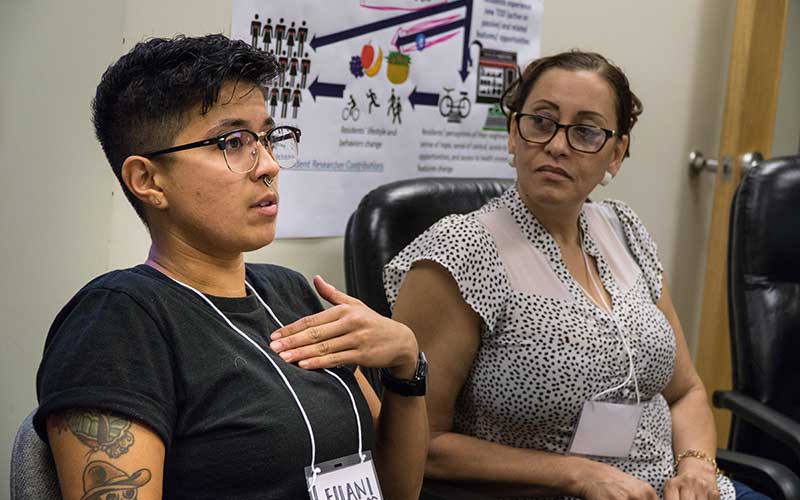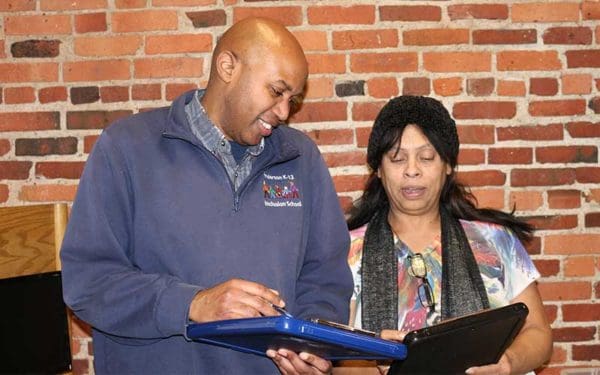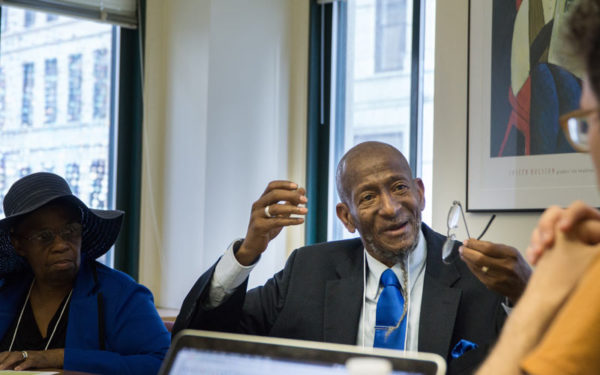
Guest writer Leilani Mroczkowski, a Community Engagement Coordinator for GreenRoots, speaks with residents at a community meeting about their experiences with gentrification.
Leilani Mroczkowski is a Community Engagement Coordinator for GreenRoots.
I’m always struck by how open people are to sharing their stories. Usually, all you have to do is ask. But what’s more important is to listen.
On a hot summer evening this past August, I joined five young researchers in the GreenRoots Environmental Chelsea Organizers (ECO) program on a trip to Chelsea’s Early Learning Center to meet with community residents. The researchers are not yet out of high school but, having lived in Chelsea all their lives, they have experienced firsthand the negative economic impact gentrification has had on their own families.
To combat the growing tide of displacement that residents such as these teens and their families are facing, GreenRoots, a community-based organization, is dedicated to improving and enhancing the urban environment and public health in Chelsea. It is supported by Conservation Law Foundation’s Healthy Neighborhoods Study, which gathers data on the links between neighborhoods and health.
Longtime Residents Offer Invaluable Insights into Community Challenges
These young “resident researchers” were eager to interview their neighbors about changes going on in the community and hear how those changes were directly impacting their lives. As community engagement coordinator for the GreenRoots ECO youth program and a member of the Healthy Neighborhoods Study coalition, I know how vital the voices of longtime residents are to protecting and guiding the best ways for neighborhoods to thrive and change over time. We must learn how longtime residents are affected by forces they do not control: the unrelenting, and still mounting, pressures of gentrification; the lack of food that is both affordable and healthy; the natural, green spaces that are either vanishing under concrete or off-limits to certain communities in their own neighborhoods.
In short, there is no substitute for harnessing the power of lived experience.
Luckily, interviewing people is my favorite kind of research. Personal conversations generate and capture some of the most helpful information about the places where GreenRoots works and reminds us all who we’re working for and why. The stories we hear make the work real – it’s not just research for better solutions to community needs and a healthier Chelsea; it’s making decisions that affect the lives and livelihoods of families, friends, and neighbors. It’s about parents and pets, gardens and grandchildren.
Our young researchers had it easy that night. The community residents they spoke with shared stories about health, wellness, and their own experiences openly. Connections were made immediately. The older residents and the young researchers have a lot in common—they share similar immigrant backgrounds, hailing from Central American countries such as Honduras, El Salvador, and Guatemala. They also all come from families that struggle monthly to decide which bills are essential to get paid.
Community Research is a Powerful Lever of Change in Lifting Up Disenfranchised Voices
Both the young researchers and their community elders are outspoken about their worries for the future of Chelsea and the impacts of money injected into the neighborhood, but not guided by community input. Through this research study, residents are sharing personal stories of displacement and the impact that a growing wealth gap between longtime tenants and newly arrived, affluent residents means for Chelsea.
At a community level, the data collected from the Healthy Neighborhoods Study underscores equity issues playing out all over Chelsea. For example, residents have provided input year after year into efforts such as the city’s Municipal Harbor Plan. Grassroots organizations and residents have fought hard over the years for policy changes that will create and protect recreational areas along Chelsea Creek. They have also stopped a diesel power plant and redirected ethanol trains from being routed through the city.
It takes years of dedicated organizing and tough legislative fights to achieve such community-defined and -driven “wins” aimed at stopping policies that destroy not only our natural environment but also the health and quality of life of our residents.
As we continue to survey the community to glean more data, we hear community members express their frustration at how quickly outside development money can open doors that have been closed to them for years. We also repeatedly hear worries that developer deadlines will drive changes that don’t reflect sufficient community input won’t respect the need for clean and healthy open spaces, and will marginalize longtime residents, or worse, displace entire neighborhoods.
Using Data to Determine Chelsea’s Destiny
We’re turning our listening into learning. Through Conservation Law Foundation’s Healthy Neighborhoods Study, people from my community are collecting data on neighborhood conditions, resident experiences, development, and health across the city. As a result, those whose voices are rarely heard are now part of a larger groundswell of community opinion able to influence and make change alongside those who hold institutional and economic power in Chelsea.
We are fighting to provide and protect waterfront and open spaces that benefit all community members, pushing for the establishment of an affordable farmers market with healthy produce, and calling for investments in truly affordable housing that meets the income levels of the majority of Chelsea residents.
The solutions to our struggles aren’t mysteries. Sometimes all you have to do is ask those who already know what they are.
I encourage each of you, as members and supporters of CLF’s work, to support local environmental justice issues and more equitable community solutions to health and wellness by sharing this blog on your Facebook or Twitter feed!



